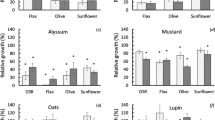Abstract
About 500 plant species from various regions of the United States have been screened previously at the USDA Northern Regional Research Center for their multipurpose, energy-producing potential. Most collections have been from the rich flora of central Illinois. For this report, 92 additional species were collected from southern Illinois and evaluated by criteria previously established at this Center. Plant samples were analyzed for “oil,” “polyphenol,” “hydrocarbon,” and protein. Oil fractions of selected species were analyzed for classes of lipid constituents and were saponified to determine yields of unsaponifiable matter and fatty acids. Hydrocarbon fractions of selected species were analyzed for rubber, gutta, and waxes. Average molecular weight and molecular weight distribution of rubber and gutta were determined. of the 92 species, complete analytical data are presented for 16 selected species. Substantial quantities of oil were obtained fromPhiladelphias coronarius (5.0%; dry, ash-free sample basis),Cacalia muhlenbergii (4.1%),Lindera benzoin (4.1 %), andKoelreuteria paniculata (4.0%). High yields of polyphenol were obtained fromAcer ginnala (33.1%),Cornus obliqua (20.8%), andSalix caprea (20.0%). Maximum yields of hydrocarbon and protein were fromElymus virginicus (0.6%) andLindera benzoin (11.1%), respectively. Data are discussed with respect to species previously analyzed at this Center.
Similar content being viewed by others
Literature Cited
Archer, B. L., and B. G. Audley. 1973. Rubber, gutta percha and chicle.In L. P. Miller, ed, Phytochemistry, Vol. 5, p. 310–343. Van Nostrand Reinhold, New York.
Bagby, M. O., R. A. Buchanan, and F. H. Otey. 1980. Multi-use crops and botanochemical production.In D. L. Klass, ed, Biomass as a Nonfossil Fuel Source, Amer. Chem. Soc. Symposium Series No. 144: 125–136.
Black, L. T., G. E. Hamerstrand, F. S. Nakayama, and B. A. Rasnik. 1983. Gravimetric analysis for determining the resin and rubber content of guayule. Rubber Chem. Technol. 56: 367–371.
Buchanan, F. H., I. M. Cull, F. H. Otey, and C. R. Russell. 1978a. Hydrocarbon and rubber-producing crops. Evaluation of U.S. plant species. Econ. Bot. 32: 131–145.
—, F. H. Otey, C. R. Russell, and I. M. Cull. 1978b. Whole-plant oils, potential new industrial raw materials. J. Amer. Oil Chem. Soc. 55: 657–662.
—, I. M. Cull, F. H. Otey, and C. R. Russell. 1978c. Hydrocarbon and rubber-producing crops. Evaluation of 100 U.S. plant species. Econ. Bot. 32: 146–153.
—, C. L. Swanson, D. Weisleder, and I. M. Cull. 1979. Gutta-producing grasses. Phytochemistry 18: 1069–1071.
—, F. H. Otey, and M. O. Bagby. 1980. Botanochemicals.In T. Swain and R. Kleiman, ed, Recent Advances in Phytochemistry, Vol. 14, p. 1–22. Plenum, New York.
—, and J. A. Duke. 1981. Botanochemical crops.In O. R. Zaborsky, T. A. McClure, and E. S. Lipinsky, ed, CRC Handbook of Bisolar Resources, Vol. 2, p. 157–179. CRC Press, Boca Raton, FL.
Bungay, H. R. 1982. Biomass refining. Science 218: 643–646.
Calvin, M. 1983. New sources for fuel and materials. Science 219: 24–26.
Campbell, T. A. 1983. Chemical and agronomic evaluation of common milkweed,Asclepias syriaca. Econ. Bot. 37: 174–180.
—, 1984. Agronomic and chemical evaluation of smooth sumac,Rhus glabra. Econ. Bot. 38: 218–223.
Cocks, L. V., and C. van Rede. 1966. Chemical characteristics.In Laboratory Handbook for Oil and Fat Analysts, p. 113–126. Academic Press, London and New York.
Cull, I. M. 1983. Midwest plants for potential crops. Trans. Illinois State Acad. Sci. 76: 203–212.
Davis, J. B., D. E. Kay, and V. Clark. 1983. Plants tolerant of arid, or semi-arid, conditions with non-food constituents of potential use.In Report of Tropical Products Institute, G150, p. 1–172. Tropical Products Institute, London.
Kent, E. G., and F. B. Swinney. 1966. Rubber and applications of trans-1,4-polyisoprene. Ind. Eng. Chem., Prod. Res. Dev. 5: 134–137.
Knowles, P. F., K. J. Lessman, and 21 other task force members. 1984. Development of new crops: Needs, procedures, strategies, and options.In Council for Agricultural Science and Technology, Report No. 102, p. 1–30. Headquarters Office, Ames, IA.
McKennon, F. L., and J. R. Lindquist. 1944. Compounding of goldenrod rubber. Rubber Age 56: 289–292.
Mills, C. D., P. J. Yeo, and B. R. Smith. 1975. Compound processability and molecular weight distribution of SBR. Rubber Ind. 9: 25–33.
Princen, L. H. 1983. New oilseed crops on the horizon. Econ. Bot. 37: 478–492. Rawls, R. 1983. Crops sought as high chemical energy source. Chem. & Eng. News 61: 20.
Roth, W. B., I. M. Cull, R. A. Buchanan, and M. O. Bagby. 1982. Whole plants as renewable energy resources: checklist of 508 species analyzed for hydrocarbon, oil, polyphenol, and protein. Trans. Illinois State Acad. Sci. 75: 217–231.
—, M. E. Carr, I. M. Cull, B. S. Phillips, and M. O. Bagby. 1984. Evaluation of 107 legumes for renewable sources of energy. Econ. Bot. 38: 358–364.
Swanson, C. L., R. A. Buchanan, and F. H. Otey. 1979. Molecular weights of natural rubbers from selected temperate zone plants. J. Appl. Polym. Sci. 23: 743–748.
Author information
Authors and Affiliations
Additional information
The mention of firm names or trade products does not imply that they are endorsed or recommended by the USDA over other firms or similar products not mentioned.
Rights and permissions
About this article
Cite this article
Carr, M.E. Plant species evaluated for new crop potential. Econ Bot 39, 336–345 (1985). https://doi.org/10.1007/BF02858804
Received:
Accepted:
Issue Date:
DOI: https://doi.org/10.1007/BF02858804




